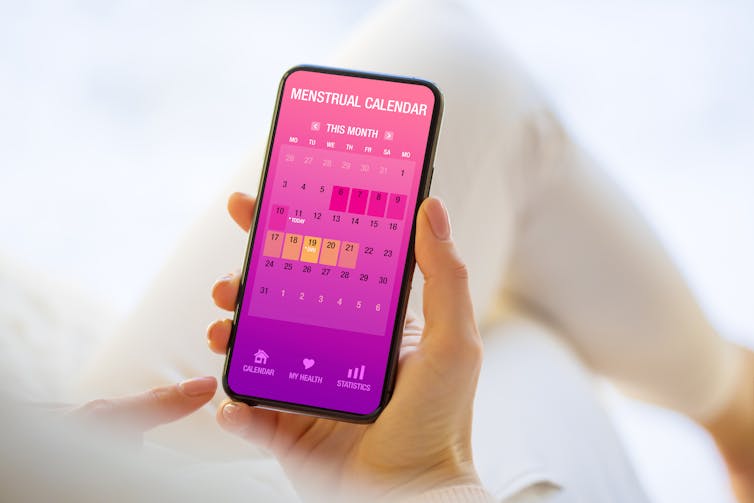Menstruation is often seen as a negative experience, with symptoms that can be disruptive to daily life. Participation in sport and physical activity is particularly affected, with 78% of teenage girls reporting they avoid exercise while on their period.
Elite athletes have also reported their performance is negatively affected by their period. So, how do we reduce or manage period-related symptoms? The first step is understanding our menstrual cycle.
There are phases of the menstrual cycle, based upon hormonal fluctuations, where certain symptoms are more frequently experienced. The two main phases are the follicular phase and the luteal phase and they are divided by ovulation. A menstrual cycle should last between 21 and 35 days, with menstruation indicating day one of the cycle and the number of days until the next bleed. Ovulation is approximately half way through the cycle.
This article is part of Women’s Health Matters, a series about the health and wellbeing of women and girls around the world. From menopause to miscarriage, pleasure to pain the articles in this series will delve into the full spectrum of women’s health issues to provide valuable information, insights and resources for women of all ages.
You may be interested in:
Five old contraception methods that show why the pill was a medical breakthrough
The orgasm gap and why women climax less than men
This is different for those taking hormonal contraceptives, as their natural hormone levels are suppressed by the synthetic hormones and any bleed is known as a “withdrawal bleed”, which is not equivalent to a period.
During the follicular phase, hormone levels are low to begin with. The first three to five days are the time of menstruation and an increase in oestrogen occurs prior to ovulation. For some, this phase provides many positive symptoms of increased confidence, energy and motivation.
After ovulation, hormone levels are higher, with a peak in progesterone and a secondary peak in oestrogen. It is during this time that the menstrual cycle is frequently associated with negative symptoms such as bloating, fatigue and changes in mood.
But we know that menstrual-related symptoms can be improved through diet, sleep, reducing stress and exercising. So taking a proactive approach can help to promote sports performance on every day of the menstrual cycle.

Kaspars Grinvalds/Shutterstock
1. Track your cycle
Tracking your menstrual cycle and related symptoms is crucial to taking a proactive approach. Note the first day of your period to check you are having a regular cycle. This is an important marker for both reproductive and holistic health.
Record any symptoms such as stomach cramps, fatigue and tiredness, changes in mood, anxiety and breast tenderness, along with life events. This helps to determine what’s caused by the menstrual cycle as opposed to other factors.
Complete this for at least three cycles to identify your own pattern. Everyone has a unique experience of the menstrual cycle and related symptoms.
See a doctor if your cycle consistently lasts less than 21 days, is longer than 35 days or absent for three months or more, after the first two years of having periods. If any symptoms are debilitating and affect your daily activities, this is not normal and you need to seek medical advice.
2. Improve your diet and hydration
Eat a well-balanced diet, because this will help give you the energy for training and sport, while also reducing bloating and managing cravings.
If you train hard, ensure you are fuelling your training appropriately to support your menstrual cycle. This changes according to what activity you’re participating in. For example, for high intensity workouts, you will need some quick releasing carbohydrate such as a banana or an energy drink during your session, as well as before and after.
If you can, don’t eat too many processed foods such as takeaways, sugary drinks and crisps. Try to eat at least five portions of fruit and vegetables every day. Batch cooking meals can help achieve this – have food prepared in the freezer ready for when you are tired, lacking motivation or short on time.
Drinking plenty of water is also important, as it will help to reduce bloating.
3. Get better sleep
Sleep is vital because a lack of sleep or poor sleep quality can make many menstrual cycle-related symptoms worse.
Sleep hygiene strategies can help prevent symptoms. These include going to bed and getting up at a similar time each day, starting the day with sunlight and limiting your caffeine intake (especially in the afternoon).
4. Reduce your stress
Stress increases the severity and duration of symptoms related to the menstrual cycle and is therefore an important factor to manage.
This is individual and finding a strategy that works for you will differ from person to person. Some ways to reduce stress could include socialising with friends, or meditating. Plan these in advance to prevent stress rather than reacting once you are already stressed.
5. Stay active
Sometimes getting to training is the hardest part when experiencing menstrual-related symptoms. Consider other activities such as walking or yoga to manage symptoms like stomach cramps while you are implementing the above strategies. And if there are days when you have more energy and motivation, maximise them while you are getting to understand your menstrual cycle.
You can use heat and pain relief for symptoms such as stomach cramps. Have these to hand if stomach cramps are affecting your ability to train around the time of menstruation. You could also speak to your trainer to adapt a session if required.
The menstrual cycle has long been seen as a negative thing. And there has not been enough information on how to manage symptoms. But we must change that narrative. Symptoms can be managed or reduced so you can continue to participate in sports and other activities. Don’t feel ashamed of your period – take control and be proactive in managing it.



